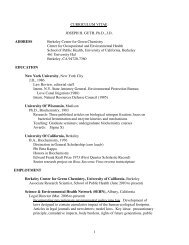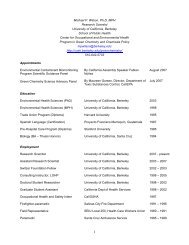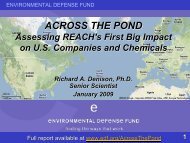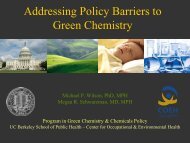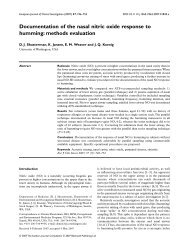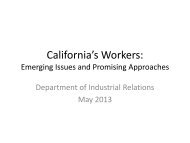Pesticide and Toxic Chemical News - University of California, Berkeley
Pesticide and Toxic Chemical News - University of California, Berkeley
Pesticide and Toxic Chemical News - University of California, Berkeley
Create successful ePaper yourself
Turn your PDF publications into a flip-book with our unique Google optimized e-Paper software.
<strong>Pesticide</strong> <strong>and</strong> <strong>Toxic</strong> <strong>Chemical</strong> <strong>News</strong>Panel gives <strong>California</strong> more options to consider for Green Chemistry InitiativeMonday June 09 2008By addressing the data, safety <strong>and</strong> technology gaps associated with chemicals, <strong>California</strong>will stimulate innovation <strong>and</strong> investment in green chemistry, according to a new reportfrom the state's Green Chemistry Initiative Science Advisory Panel.The panel (SAP) has set forth 38 different options for the state to address these gaps.Twenty-one options make up the "supply-side" <strong>of</strong> green chemistry, such as education <strong>and</strong>research initiatives, to spur on green chemistry innovation, <strong>and</strong> 17 fall on the "dem<strong>and</strong>side,"including developing <strong>and</strong> improving chemical regulations, to encourage dem<strong>and</strong>for green chemistry.The May 28 panel report adds 38 more options to the more than 800 suggestionssubmitted by stakeholders during the first phase <strong>of</strong> the initiative's development (seePTCN, Feb. 4, Page 1). The report is part <strong>of</strong> the second phase, which also includes publicinput on the many options suggested, <strong>and</strong> an analysis <strong>of</strong> the options by interagency teams,which will hone them down into more focused policies for submission to Gov. ArnoldSchwarzenegger (R) <strong>and</strong> the state legislature in July."The overarching concept <strong>of</strong> the report is that we both need to create a supply <strong>of</strong> greenchemistry <strong>and</strong> a dem<strong>and</strong> for it," panel member Richard Denison, senior scientist withEnvironmental Defense Fund, told <strong>Pesticide</strong> & <strong>Toxic</strong> <strong>Chemical</strong> <strong>News</strong>, adding that thereport's intent is to lay out a whole spectrum <strong>of</strong> options with the idea that no one optionwill be enough for the Green Chemistry Initiative. "A balanced portfolio is going to beneeded," Denison said.The advisory panel is made up <strong>of</strong> 21 representatives from industry, academia <strong>and</strong> nongovernmentalorganizations. "While many <strong>of</strong> these options enjoy broad support amongthe panel members, the degree <strong>of</strong> support for any single option is neither stated norimplied," the report cautions.While the panel did not aim to reach consensus on the options, according to panelmember Mike Wilson, a research scientist with the Program in Green Chemistry <strong>and</strong><strong>Chemical</strong>s Policy at the <strong>University</strong> <strong>of</strong> <strong>California</strong>, <strong>Berkeley</strong>, the panel — a diverse group<strong>of</strong> "strongly opinionated" people — ultimately agreed that there are structural <strong>and</strong> legalproblems that need to be addressed to motivate the development <strong>and</strong> adoption <strong>of</strong> greenchemistry.
"[The report] calls out <strong>and</strong> affirms the problems with chemicals management in theUnited States," Wilson told PTCN. "It articulates a national debate on how we as acountry motivate investment in safer alternatives."The panel was formed to guide the Department <strong>of</strong> <strong>Toxic</strong> Substances Control — the lead<strong>California</strong> EPA department on developing the state's Green Chemistry Initiative — onscientific matters. Options range from teaching green chemistry <strong>and</strong> incentives to boostgreen chemistry supply <strong>and</strong> dem<strong>and</strong> to identifying <strong>and</strong> prioritizing chemicals <strong>of</strong> concern.Three options proposed by SAP members focus on chemical regulation as a means toaddress chemical data <strong>and</strong> safety gaps. According to Denison, such data would allowpeople to differentiate between a toxic chemical <strong>and</strong> a safer alternative, thus creatingdem<strong>and</strong> for green chemistry.Option 26 would require chemical companies in the state to provide CalEPA withspecific information about chemicals, including persistence, bioaccumulation, toxicity,uses <strong>and</strong> likely exposures. This option would also give CalEPA broad authority to requestadditional information <strong>and</strong> take action against those who don't comply.Option 27 is similar to Option 26. "But in contrast, this option does not force chemicalmanufacturers or importers to generate new data, only to provide CalEPA with relevantinformation that they have already reported to other authorities," according to the report.Option 28 would require manufacturers <strong>and</strong> importers in <strong>California</strong> to disclose thechemical ingredients in their products, although the exact composition, such as thepercentages <strong>of</strong> ingredients would not be required.Options to address the green chemistry technology gap include providing incentives —either through award recognition or financial assistance — to encourage chemicalcompanies to adopt green chemistry practices. Wilson noted that EPA has already donesome <strong>of</strong> that, giving the Presidential Green Chemistry Challenge Awards as an example.Industry reactionAccording to Sarah Brozena, senior director <strong>of</strong> regulatory <strong>and</strong> technical affairs at theAmerican Chemistry Council (ACC), a lot <strong>of</strong> the options in the report are consistent withideas that ACC supports, including: green chemistry programs <strong>and</strong> incentives; providingmore information on chemical hazards, risks <strong>and</strong> exposures; <strong>and</strong> leveraging existing data."There's a lot <strong>of</strong> information out there already <strong>and</strong> a lot being developed," she said,giving the Canadian Domestic Substances List, Europe's REACH regulation <strong>and</strong> EPA'snew <strong>Chemical</strong> Assessment <strong>and</strong> Management Program as examples.John Ulrich, executive director <strong>of</strong> the <strong>Chemical</strong> Industry Council <strong>of</strong> <strong>California</strong>, laudedthe report, noting that it is from "a prestigious group <strong>of</strong> experts" <strong>and</strong> will "move the ballconsiderably forward" in terms <strong>of</strong> the Green Chemistry Initiative. But Ulrich alsoexpressed some disappointment that the report doesn't address a timeline. There is nowhat comes first, what comes second, he told PTCN. He emphasized the need for a
structure to be in place to move forward with the initiative, including establishing goals,<strong>and</strong> metrics as well as setting a timeline to measure progress.UC <strong>Berkeley</strong>'s Wilson noted that the report did not address a timeline, but in his opinionchemical data gaps need to be addressed first. Many companies have complained thatthey don't have health <strong>and</strong> safety information on the substances in their supply chains, headded. And in many cases, the chemical manufacturers don't have that information, hesaid.Ulrich declined to discuss specific options in detail, saying that focusing on one option oranother "takes away from the contribution <strong>of</strong> the whole report." However, he noted,"embedded in each one <strong>of</strong> the options are a whole host <strong>of</strong> additional conversations thatneed to take place." For example, Ulrich said that while the regulatory options may bemore difficult for some, they may seem easy for other stakeholders. And while he mayagree with the recommendations about green chemistry education, educators may not bereceptive to having their programs changed.Panel member Bill Carroll, a vice president at Occidental <strong>Chemical</strong> Corporation, did notrespond to a request for comment.A copy <strong>of</strong> the panel's report can be accessed at www.dtsc.ca.gov by clicking on the"Green Chemistry" tab.— Liz Buckley elizabeth.buckley@informa.com



